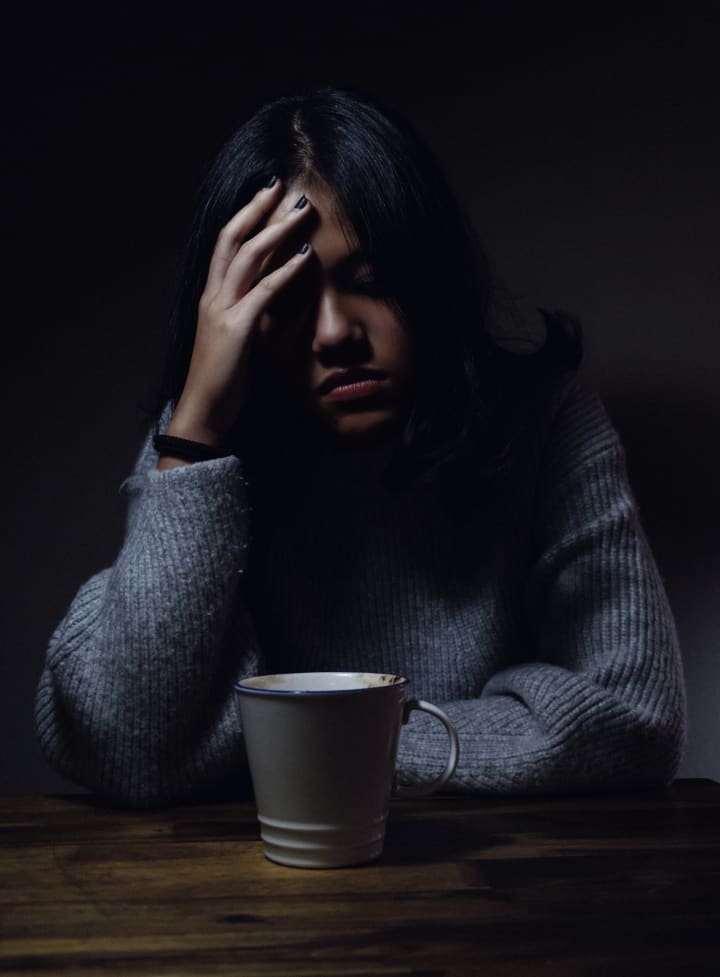7 Different Types of Migraines & Why Smells Might Trigger Yours
Learn About Migraines & Osmophobia

If you've ever experienced a migraine, you don't need to be told how bad they can get or what can worsen them.
For myself I get naseous and become sensitive to not only sounds but lights and smells.
Even worse smells can trigger my migraines.
Not all smells of course and not every perfume but every now and then a perfume, a detergent , or a dryer sheet will absolutely ruin my day and give me a migraine that lasts hours.
I thought for the longest time I was alone, or it was just a strange phenmonen or coincidence.
Now I know differently.
Before we talk about why smells trigger a migraine lets review the types of migraines, starting with the most common.
1. Migraine without aura
Most common symptoms: throbbing pain that starts on one side of your head (for many sufferers, migraines tend to start behind the left eye), moving around tends to make the pain worse, and it’s normal to feel nauseous, dizzy, and sensitive to light and sound.
Duration: 4-72 hours
The first and most widespread type of migraine is known as the common migraine. It, like other headaches formally recognized by doctors, is listed in the International Classification of Headache Disorders.
If, for at least three months in a row, you get a headache more than 15 times per month, and eight of them have migraine symptoms, that means your migraines might be becoming chronic. Chronic migraines will typically have the same symptoms as episodic migraines that just pop up now and then, according to the American Migraine Foundation.
When you get a common migraine, you might also notice that you feel strange in the hours or days before the actual headache sets in. This is called the “prodrome,” which is medical lingo for the first phase of a migraine attack. The prodrome can bring on:
- Difficulty speaking or reading
- Increased urination
- Irritability and depression
- Food cravings
- Frequent yawning
- Muscle fatigue or tight or stiff muscles, particularly in the neck and shoulders
- Nausea, constipation, or diarrhea
- Poor concentration
- Sensitivity to light, sound, touch, and smell
- Trouble sleeping
As if that’s not enough, after the 4-72-hour headache hits, it’s normal to get a “migraine hangover,” or postdrome. The hangover can make you:
- feel moody
- feel sensitive to touch, especially in the areas where your headache was focused
- feel tired
- have stomach issues
- Here’s some more info about how the common migraine progresses.

2. Migraine with aura
Most commonly felt symptoms: visual disturbances before a migraine begins, followed by common migraine symptoms
Duration: can range from a few minutes to a full hour, usually before the migraine attack itself starts. The migraine itself can last from 4-72 hours.
About 25% of people who suffer from migraines also experience aura. Migraine with aura is a broad category listed in the International Classification of Headache Disorders-3, and can cause visual disturbances and neurological symptoms, as well as unpleasant feelings like a numb face or tongue, and pins and needles that spread across your body.
The International Classification of Headache Disorders3 break these down even further into four types: typical aura, brainstem aura, retinal aura, and hemiplegic.
Typical aura can bring on visual symptoms, such as temporary blind spots, geometric patterns, zigzag lines, stars or shimmering spots, and flashes of light, notes The Mayo Clinic.
Brainstem aura involves symptoms that seem to originate in the brainstem, like difficulty speaking, double vision, ringing ears, or vertigo.
Hemiplegic migraine involves symptoms like motor weakness, or a loss in the strength of your muscles, usually on one side of your body, and according to Genetics Home Reference, you could struggle with language and feel confused or tired.
Like with typical aura migraines, these symptoms usually last just minutes and no more than an hour (however for some people, it can be longer), but memory loss and problems with your attention span can linger for weeks or even months. Sometimes, hemiplegic migraines can cause more serious issues, like seizures, coma, and long-term problems with brain function and body movement. These might be frightening facts to read, so know that these types of migraines are rare and the extreme side effects are uncommon.
Retinal migraine (a.k.a. ocular migraine and optical migraine) differs from a typical migraine with aura in that you only have visual disturbances in one eye. Because they cause visual issues, they’re sometimes called “ocular migraines” or “optical migraines.”

3. Menstrual Migraine
Most commonly experienced symptoms: this type of migraines coincides with your period
Typically lasting : 4-72 hours
Menstrual migraines, are pretty much what they sound like—migraines in women triggered by hormonal changes. They’re listed in the official International Classification of Headache Disorders-3, which notes that menstrual migraines can happen with aura or without, and usually strike just before or at the beginning of your period. If you get migraines during this time in two out of three periods, they might be menstrual migraines.
They affect about 7-19% of women. That said, most women who get menstrual migraines also have migraines at other times, too. According to the US Office on Women’s Health, menstrual migraines might be triggered by the quick drop in the hormones estrogen and progesterone that happens before your period starts.
A frustrating but good-to-know fact from the Journal of Headache and Pain is that menstrual migraines tend to last longer than your average non-menstrual migraines, and might be more painful.

4. Vestibular migraine
Commonly reported symptoms: vertigo, dizziness, and trouble with balance
Duration: few seconds to a few days
Vestibular migraines are surprisingly common, reports Cephalalgia, affecting 30-50% of migraine sufferers. To get more specific, vestibular migraines can give you sudden bouts of vertigo, where you either feel like you’re moving when you’re not, or see the world spinning, according to International Classification of Headache Disorders.
Sometimes this happens when you move your head, or when you see something particularly stimulating. Interestingly, as is listed as International Classification of Headache Disorders-3. The vertigo attacks might not always occur right before a headache sets in, like aura symptoms. In fact, Cephalalgia notes that they might last for just a few seconds or even for a few days.

5. Migraine without headache
Main Symptoms: no actual headache pain
Duration: each symptom can last 1 hour or less
If you get aura symptoms but never get the telltale splitting pain in your head, you might have a migraine without a headache, sometimes known as a “silent migraine,” “painless migraine,” or “acephalgic migraine.” The International Classification of Headache Disorders.-3 simply calls them a typical migraine with aura without a headache.
An acelphagic migraine, or a migraine with no pain, can have all the same symptoms of migraines with aura, except the headache never shows up, according to Brigham and Women’s Hospital.
Interestingly, the American Migraine Foundation notes that migraines without headaches become more likely as you get older.

6. Abdominal Migraine
Common symptoms: stomach pain instead of a headache
Duration: 1-72 hours
Yep, you read that right—abdominal. Sometimes, instead of a headache, a migraine can cause extreme pain in your abdomen. This is an abdominal migraine, and it’s more common in children than adults—though 2/3 of them end up developing migraine headaches as adolescents, reports The Migraine Trust.
The International Classification of Headache Disorders. -3 lists it as a condition that might be associated with migraines. According to the American Migraine Foundation, abdominal migraines cause pain near the belly button, and can also make you feel nauseous, give you no appetite, cause vomiting, and make you look pale.
Yale Medicine notes that, just like common migraines, abdominal migraines can be triggered by things like stress, bright lights, and food additives like monosodium glutamate (MSG). They’re also typically treated using the same medications as standard migraines with headaches.

7. Status Migrainosus
Most common symptoms: a migraine that that lasts more than 72 hours
Duration: 72+ hours
Status migrainosus is basically a migraine (with or without aura) that lasts longer than the standard max of 72 hours. The International Classification of Headache Disorders. -3 recognizes status migrainosus, and points out that overusing migraine medications could be a likely cause.
The National Headache Foundation points out other triggers can bring them on too, however, like:
- changes in food and sleep habits
- changes in medication
- changes in weather
- head and neck traumas
- hormones
- illnesses, like the flu or a sinus infection
- sinus, tooth, or jaw surgeries
- stress
Status migrainosus can be extremely frustrating, to put it mildly. The National Headache Foundation calls it a “trick candle on a birthday cake,” because the headache might briefly respond to medication, only to flood back after a break.

What's not a migraine
If none of these descriptions seem quite right, it’s possible your headaches might be something besides migraines. Other common types of headaches are:
Tension Headaches
Tension headaches are the most common headaches for adults.
The pain is typically less severe than in migraines, more of an ache than a throbbing pain.
They affect both sides of your head.
They don’t usually hurt as badly as migraines.
They don’t get worse when you’re active.
They don’t cause symptoms like sensitivity to light and sound, or nausea.
Sinus Headaches
Sinus headaches are caused by a sinus infection and are rare. The National Headache Foundation notes that people often think they have sinus headaches when they actually have migraines.
New Daily Persistent Headaches
As the American Migraine Foundation reports, new daily persistent headaches are what they sound like—headaches that suddenly begin to pop up every day, keeping you in pain for over three months, reports. You’ll need to see a doctor to learn the true cause of NDPH, but it can be treated like a migraine if the symptoms are the same.
Cluster Headaches
Cluster headaches cause extreme head pain, but, unlike migraines, they appear up to eight times per day in bursts (or clusters) of weeks or months and feel more like stabbing pain, than throbbing.
Post-Traumatic Headaches
According to the American Migraine Foundation, post-traumatic headaches happen after a traumatic injury, and can cause symptoms that mimic migraines, like severe throbbing pain that gets worse if you move around, nausea and vomiting, and sensitivity to light and sound. It typically ends within a few months but can become “persistent” and last longer, especially if you have a family history of or already suffer from migraines.
If you have painful, recurring headaches, you know one thing: You want them to go away. The first step is finding a doctor to help you figure out just what a kind of headache you’re dealing with. Once you know that, you’ll be better able to figure out the best treatment.
So what about those pesky smells ? Why does that happen?

Compared to those without migraines, migraine sufferers can be more sensitive to things in their environment such as light, sound, and odor. With respect to odors, this extra sensitivity is due to increased activation of specific scent and pain receptors in the brain.
In the case of strong odors, such as cologne and perfume, experts believe these odors, even if they're otherwise pleasant, may cause a person's blood vessels to swell and dilate and, in turn, stimulate the nerve system in the brain associated with head pain.
Similarly to loud noise, motion, or strong light, strong smells have been reported to cause migraines.
Blau and Solomon (1985) reported that odors, pleasant or otherwise, could precipitate migraine in 11 out of 50 patients. Kelman reported that perfume or odor triggers migraine in about 50%.
A interesting connection is Osmophobia which means "abnormal sensitivity to smell".
Perhaps more precisely, it is fear of smell. While sound sensitivity is divided up into a variety of subcategories -- for example, misophonia, hyperacusis, phonophobia, this doesn't seem to have been paid as much attention to with smell.
Osmophobia is an uncommon symptom with few causes.
Osmophobia reported in 84% with migranous headache with aura, 74% of migranous patients without aura and in 43.3% of those with ETTH (episodic tension type headache). Most frequently the offending odors were scents (88%), foods (54.2%) and cigarette smoke (62.5%). Osmophobia starts 30 min before the headache starts in 22.7% of patients. However other smells such as perfume, colognes or detergents have been found to cause it as well. Osmophobia is the medical term for fear, dislike or aversion to smell or odors. Intolerance to smell is often reported by migraine patients; despite this, the relationship between osmophobia and headaches has not been investigated in depth.
Only two studies have evaluated the presence of osmophobia in migraine attack. The first, prior to the formulation of the International Classification of Headache Disorderscriteria, Osmophobia was demonstrated in 40% of 50 Migraineurs studied while the the 2nd, in a more recent study in a larger patient population, revealed the presence of osmophobia in 25% of migraineurs. In a recent epidemiologic study of a Latin American patient population.
Osmophobia in migraineurs was said to be “almost always” present in 47.7% of subjects.
So my curiousity finally led myself to a answer and while I don't feel afraid of smells , I can definitely say they trigger them and I know I'm not alone now. For me the most common trigger is fabric softner and perfumes, which suck because I love both of those things.
Here are some things you can do to help prevent migraines

- Exercise regularly: Exercise at least 30 minutes three times a week
- Eat a balanced diet: Eat at least three times a day, although five small meals a day is preferred
- Stay hydrated: Drink 64 ounces or more of water each day
- Get adequate sleep: Try to get into a routine of going to bed and waking up at the same time each day, getting seven to eight hours of sleep each night
- Reduce stress: Incorporate activities like therapy, massage, acupuncture and exercise to help manage your stress
Some migraines and headaches can lead to stress, feelings of depression , hopelessness and overwhelming pain including but not limited to suicidal thoughts- if you are experiencing either of these please seek help from a medical professional and find more information on this link <------

The information provided in this article is not a substitute for professional medical advice, diagnosis, or treatment. You should not rely upon the content provided in this article for specific medical advice. If you have any questions or concerns, please talk to your doctor.
Sources :
About the Creator
Misha Alsleben
Wife & Mom Fueled by ;
Caffeine & Gratitude, when I’m not writing you’ll find me raising awareness about our planet’s needs , in the kitchen ,outside with the family, taking photos or in a bookstore.






Comments
There are no comments for this story
Be the first to respond and start the conversation.